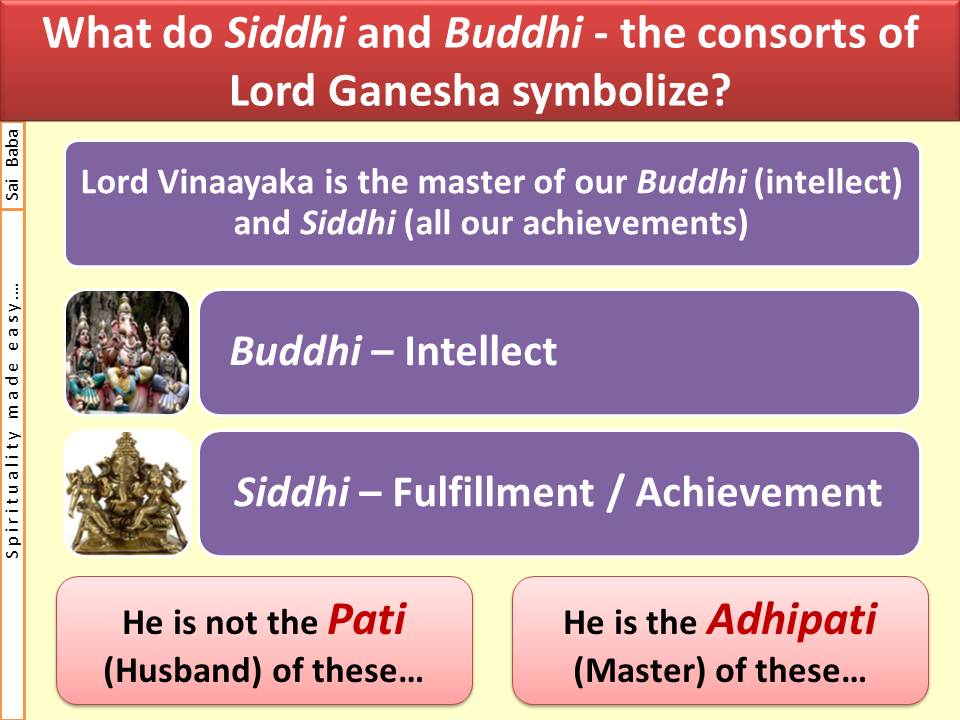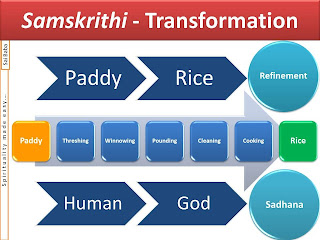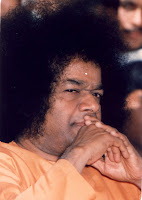Ganesha Chaturthi Special
09 September 2013
What is the inner significance of Siddhi and Buddhi – the consorts of Vinaayaka?
What is the inner significance of Siddhi and Buddhi – the consorts of Vinaayaka-2.24-1994 September 09
Vinaayaka is the one with the power and capability of supreme intelligence. Humans derive happiness and joy because of the combination of Buddhi (intelligence) and Siddhi(fulfilment or achievement). Therefore, in the worldly stories (Puranas), Siddhi and Buddhi are referred to as the consorts of Vinaayaka. Since, He is the master (adhipati) of intellect and wisdom, He is referred to as their husband (pati). Thus being the master of Siddhi and Buddhi, Vinaayaka is called the leader or the adhipati of these. Humans derive happiness and bliss because of the combination of Buddhi (intelligence) and Siddhi (fulfilment or achievement). That is why; happiness and bliss are also referred to as the children of Vinaayaka.
Such metaphors and analogies give some satisfaction to the people in the worldly and physical sense. (Truly speaking) how can Vinaayaka, who has no desires or any mental feelings, have any wives or children? Pati does not necessarily mean husband; it means adhipati (master). He is called the husband of intellect and wisdom as He is the master of these two.
09 September 1994
What is the inner significance of Siddhi and Buddhi – the consorts of Vinaayaka-2.55-2001 August 22
Vinaayaka is the one with a pure heart. Siddhi (fulfilment or achievement) and Buddhi (intellect) are His two eyes. The two eyes of Siddhiand Buddhi are regarded as His two consorts. Thus Vinaayaka is the Nayakaor the leader of Siddhi and Buddhi. To have Siddhi (fulfilment), one must have Buddhi (intellect). To have Buddhi(intellect), we must develop the feeling of gratitude in us. For the one without any gratitude, the intellect will be destroyed. Once the intellect is destroyed, how can you have any fulfilment or achievement? Sarva Siddhi Sampradaaya Namah – Vinaayaka is the one who bestows on you all the achievements (success). We need to make an effort to recognize this principle of Lord Vinaayaka.
22 August 2001
What is the inner significance of the elephant head of Ganesha?
What is the inner significance of the elephant head of Ganesha-2.43-1994 September 09
Vinaayaka has supreme intelligence. In the morning when I came to the Hostel, Sai Gita (the elephant) came towards Me trumpeting with delight! She does not trumpet at any other car. My car came and behind My car, there were another 80 cars. The moment My car came and she heard the sound of My car, she came trumpeting loudly to the road. See, how clever she is. She has so much wisdom and intelligence. That is why any individual who is very intelligent is generally referred to as the one having the intelligence of an elephant (gaja telivi – elephant intelligence). The elephant has such supreme intelligence. Therefore, the reason behind placing an elephant head for Vighneshwara, is to declare to the people through this symbol, that He is the one of great intelligence. Otherwise, why else would they create Him with human hands and legs and with the head alone as an elephant head? They gave maximum importance to His intelligence (medha shakti – power of intelligence).
Apart from the above, it is necessary that we must first listen to anything that is said. In Vedanta, the three most important aspects are Sravanam (listening), Mananam(contemplating) and Nidhidhyaasanam(assimilating). Only when you hear first and contemplate subsequently, you can put something into practice. Without listening and without contemplating, how can you put anything into practice? Therefore, Sravanam – the ears of the elephant are very large, which means that it hears properly to everything. Whether criticism (dushanam) or praise (bhushanam), it listens to both. But what does it do with praise (bhushanam)? It nicely takes it inside. And what does it do with criticism (dushanam)? It hits it again and again (with its large ears) and throws it out. Thus it accepts good things into it and throws away bad things outside. This is the inner significance of the elephant head.
09 September 1994
What is the inner significance of the elephant head of Ganesha-2.55-2001 August 22
Vighneshwara is created with the head of an elephant and the vehicle of a mouse to declare to the world the ideal and the truth that Divinity is not limited to the human form only. Divinity exists even in insects and in all beings. The elephant is supremely intelligent. It is full of loyalty. It will never forget its master, even if it loses its life. Without forgetting the master, so long as it is alive, with the principle of Divinity in it, it nurtures a sense of gratitude. The elephant stands for the quality of gratitude. Gratitude is a very sacred quality. Kshama (forbearance) is truth, kshama is dharma, kshama is vedam, kshama is non-violence, kshama is indeed everything. The elephant is the very embodiment of kshama (forbearance). The elephant would be ready to even give up its life, but it will never tolerate any pain to its master.
The elephant shows the ideal path to humanity. In a forest that has no paths or roads, once an elephant walks through, a pathway is automatically created for the people. Therefore, in this forest of life, for the people who cannot see the pathway, the elephant (Ganesha) preaches and shows the path. The one donning the head with such intelligence is Vinaayaka. Therefore Vinaayaka means the one with intelligence, who shows the ideal path to mankind.
22 August 2001
What is the inner significance of the Mushika (mouse) being the Vaahana (chariot) of Lord Ganesha?
What is the inner significance of the Mushika(mouse) being the Vaahana (chariot) of Lord Ganesha-2.02-1995 August 29
What is this elephant head and a mouse vehicle for Ganesha? The mouse is called a Mushika. The Mushika is a symbol for the night. Night stands for darkness. Therefore, the mouse symbolizes darkness (darkness of ignorance). Since, Ganesha has trampled the darkness beneath Him (kept it under check), He is referred to as the one having a mouse as a vehicle. Vinaayaka is the master who dispels the darkness and bestows light on the world.
Mushika is also a symbol of Vaasanaas(tendencies). The mouse keeps travelling to places based on vaasana (smell). Therefore, Vinaayaka is the one who has total control over desires, tendencies and ignorance.
The mouse is the chariot of Vinaayaka. What is the meaning of a chariot? Chariot is the one which is below the rider. The one boarded on it is the master. Therefore, Vinaayaka is the master who has control over the tendencies, desires and ignorance.
29 August 1995
What is the meaning of the title Vinaayaka?
What is the meaning of the title Vinaayaka-1.38-1994 September 09
He is also known as Vinaayaka. Vinato Naayaka Iti Vinaayaka – The one without any master (leader) is Vinaayaka. Vinaayaka has no leader. He is all independent (absolutely free). Everybody (in this world) has some leader (master), everybody has some authority above them, but Vinaayaka has no master. The one with the mind alone has a master. But, where is the (need for a) master for the one without a mind? Thus, Vinaayaka is the principle that transcends the state of amanaska(mindlessness). Without understanding this true principle of Vinaayaka, we merely regard Him as the physical and visible form having the trunk of an elephant, with four hands and with ears like fans. Vinaayaka is the master for the entire world, the universe, and all the beings.
09 September 1994
What is the meaning of the name Ganaadipati and Ganapati?
What is the meaning of the name Ganaadipati & Ganapati-2.22-1995 August 29
Vedas describe Ganesha as Ganaadipa. Who are these Ganas?
(Gana indicates the republic, the assembly. Alternatively, Gana may also be taken as the attendants or the warriors of Lord Shiva. For further details:
Are these angelic Ganas or demonic Ganas? They refer to the angelic Ganas. Where do these Ganas exist? Are they roaming around in the outer world or are they part of the inner world of the human body? Being the master of all the Ganas (angels), He is called Ganaadipa.
Gana actually means the five senses. The principle of the five Karmendriyaas (instruments of action – conative) and the five Jnaanendriyaas(instruments of perception – cognitive) take the form of the Ganas. The master of all these ten senses is the mind. Mind being the master of the ten senses (Indriyas) is given the tile of Indra. Further, the Buddhi (intellect) is the master of the mind. Therefore, Ganesha is called Gana (senses)-dhi (intellect)-pati (master).
Next, what is the meaning of the word Ganapati? “Ga”means Buddhi (intellect). “Na” means Vijnaana (wisdom). As He is the master (Pati) of the intellect (Ga) and wisdom (Na), He is called Ganapati. Buddhi (intellect) is the master of the mind. Mind is the master of the senses. And as He is the head of all the Ganas (senses), He is called Ganapati.
29 August 1995
What is the message that the family of Lord Shiva conveys?
What is the important message that the family of Lord Shiva conveys to us-1993 September 19
This is a family of four members: Iswara, Parvati, Vighneshwara and Subramanyam. They symbolize Paramatma (Divinity), Prakruti (Nature), Buddhi (Intellect) and Siddhi(Fulfillment) respectively. These four stay together in unity. If we enquire about this from a worldly point of view, the chariot of Iswara is the bull and the chariot of Pravati is the lion. The bull and the lion are great enemies. (Swami sings the Telugu song – Tandava Kelisalpene Parameswarudu Sri Sambasivudu…). Lord Shiva has the Ganga on His head and fire (in the form of the third eye) in His face (forehead). Fire and water are opposites. However, they remain there without assuming or manifesting any opposition. Given all this, the family dances the Tandava dance.
Swami continues singing the Telugu song…. Tandava Kelisalpene…
The Iswara principle brings about equality (unity) among all the opposites. The head of Vighneswara is an elephant’s head. His mother’s chariot is the lion. The elephant cannot survive if the lion appears even in its dream. Though being opposites, they live so intimately. The chariot of Subramanyam is a peacock. The ornaments of Iswara are serpents. These two are totally against each other. But all of them live together in unity. All this is a symbol to set an ideal to the world. Divinity thus demonstrates an ideal life to the entire world. Vighneswara has a serpent as a waist band. The chariot of Subramanyam is a peacock. Watching a peacock, the serpent just runs away. However such opposite or contradictory relationships experience unity in Iswara’s family. The family of Iswara demonstrates the symbol of unity to the world.
19 September 1993
09 September to 15 September 2013
Why does Swami often address us as Bangaaroo (Gold)?
Why does Swami often address us as Bangaaroo(Gold)-2.03-2000 July 16
 |
| Bangaaroo |
I often call you as Bangaaroo, Bangaaroo (gold, gold). What do we mean by Bangaaroo(gold)? You are the one with Hiranyagarbha(golden womb – cosmic principle). Hiranyagarbhaaya Namah (obeisance to the Hiranyagarbha– cosmic principle). Your entire heart is full of the principle of Hiranya (gold). The gold may be converted into any ornament. If not an ornament, it can be at least kept as a coin. Therefore, the one that gets transformed into certain forms is gold, the one without any form is also gold. Thus, with a form you are gold and even in the formless state you are gold.
Enquire a little into the nature of gold. (For example), if a customer takes a small amount of gold, he is asked to pay Rs.500. However, if some copper is mixed with the gold, the value comes down to Rs.300. Further, if some brass is mixed into it, the price further comes down to Rs.200. What is the reason for the price to come down? Mixing (adulteration) is the cause for the price to come down. Why should you mix this copper and brass with pure gold? Because of mixing with these, the value of gold goes down.
(Similarly) when we are born, we are pure and highly valuable. However, as we grow, the copper of desires get mixed into us. The brass of ego also gets mixed into us. Consequently, our value goes down. What is the reason for our value to go down? The reason is the mixing of valueless materials with that which has high value. Therefore, we should not allow cheap materials (desires and ego) to get into us.
16 July 2000
Teachers Day Special
O5 September 2013
Who is a true teacher (Acharya)?
Who is a true teacher-Acharya-3.29-2001 November 21
.jpg) |
| The Universal Teacher
|
The teacher is an Acharya. What is the meaning of an Acharya? Acharya is not merely a teacher. Acharya is the one who practices and then teaches. Therefore, the name Acharya is given because the teacher is supposed to practice and then teach. First follow and then teach the children. Children may have some bad habits. The teachers must first of all control these bad habits themselves and then train the children accordingly. If the teacher himself sits in the college and keeps smoking, the children too would come smoking to the school, the next day. The teacher may shout at the student, “Aye, why are you smoking?” The student would reply, “Sir, you too are smoking”. What reply can the teacher give to this question? No reply. He can only apply, but no reply.
Therefore, if you want to teach the student, then you must not practice this bad habit in front of the student. If you practice any bad thing, the students too will start following you. Whatever you think is good and you want to teach to the students, you must practice first. Do good and teach good. This is the correct way of teaching and the right characteristic of education. With this, the goodness in the students will manifest itself. Such a student will come to the teacher and will confess on his own, “Sir, I have committed so many mistakes unknowingly. I have done this, I have done that….” Saying so, from that day onwards the student will turn into a good person.
I know this very well as I punish the student in many ways. I shout at them, I advise them, I love them, I give them everything; but at times, I am very stern. At such times, the children come on their own to Me and say, “Swami, I have committed a mistake. Please forgive me. I have not been able to follow what You have said. Now I am able to recognize the truth in what You said. Henceforth, I will not commit such mistakes.” Swami melts at this and responds, “Son, be good hereafter. Ensure that you do not change again. Whatever I do is for your own good.” Teachers also should teach their students like this.
21 November 2001
O2 September to 08 September 2013
What is the real purpose of human birth?
What is the real purpose of human birth-1.12-1999 November 18
Serve the world. We are born in this world for undertaking service and not for wielding authority. What is this authority? We are born mainly to serve others. God made us take birth (in this world) only for the purpose of service. Therefore, understand the truth that we are born for service. Service does mean government service or this or that service (i.e. your jobs). You can do your respective services (jobs). But the real service is service to humanity, service to the world. Help the poor. Serve the sick people. Give strength and empower the weak people. Life is not meant for earning money to fill our stomachs alone. Recognize the truth that there are crores of people out there who also have a stomach that needs to be filled. They go through so many difficulties. We must take the initiative to help and serve such people. Then alone will our lives be truly fulfilled.
18 November 1999
28 August 2013 – Krishnaashtami Special
What is the significance of the Gopikas churning the curd to get butter?
What is the inner significance of the Gopikas churning the curd to get butter-3.25-1994 August 28
Yashoda said, “Krishna, you do not eat what I am offering to you. You go to the houses of the cowherds and collect fistfuls of butter from their pots and eat it. The matter has come to the knowledge of all on the streets. What is this madness? Is there no butter in our house? Why should you not eat when I offer to you? Why does the butter from other houses appear so tasty for you? Because you steal that butter, the whole village is full of noisy complaints. Your full mouth has the smell of butter. The entire village is protesting with so many complaints. You are such a small child. Why are making so much mischief in this Gokulam? You should not do this.”
Krishna replied, “Mother, I am not taking the butter. I am taking away their hearts. The heart is pure. Mother, do you know how their hearts are? Nirgunam (attributeless), Niranjanam (blemishless), Sanaatanam (eternal), Niketanam (ever immersed in oneself), Nitya (permanent), Shuddha (ever pure), Buddha(ever illumined), Mukta (totally free), Niramala (immaculate) Swaroopinam (embodying all these). Such butter (heart) is not available in our home.
You ask me as to why I find the butter of their houses so tasty. In the early hours of the morning, the Gopikas insert the churning rod into the curd inside the pot. They wind the rope around the rod, and as they churn the curd taking the name of Krishna, their bangles (hit against each other and) give the right taalam (music beat) to the chanting of the name of Krishna. The swirling of the rope around the churning rod is like the shruthi (musical note). With this shruthi (musical note) and taala (beat), they churn the curd. After the churning, the one which floats on the top is the butter.
Therefore, mother, the hearts of the Gopikas are like the pots. They immerse the churning rod of the buddhi (intellect) into their heart; tie the rope of love around it; and churn with the chanting of the name of the Lord; The nectar that emerges from their heart is the very essence of all the Vedas and that is the real butter. This butter is the nectar that emerges from the churning of all the shastras(scriptures). Does this happen in our house? Do you chant the name of Krishna? You get the curd churned by somebody else in the morning. The butter of the Gopikas is so very tasty.”
28 August 1994
What is the inner significance of Krishna stealing the Butter?
What is the inner significance of Krishna stealing the Butter-6.00-2002 May 29
 |
| Krishna is the stealer of hearts!! |
Not all can recognize the reality of Krishna. We think, “Oh! He is the son of Yashoda, who indulges in silly acts like taking butter from one house and dropping it in another’s house.” Why should Krishna indulge in this type of “cheating”? We consider this as “cheating”. No, it is not cheating at all. There is a lot of significance in this. What exactly is butter? When milk (after curdling and transformed into curd) is churned and the essence is extracted from it, it assumes the form of butter. Similarly, to bring forth or manifest God (as unity), who resides in all forms of life (as diversity), such churning has to be carried out. There is Divinity in such unity.
Wherever Krishna went, people thought that He had committed theft. “Theft” is a very bad word (bad accusation). If he were to be a thief, why would he leave traces of butter smeared all over his face? No, no, no. Yashoda herself had this doubt, and asked, “O Krishna! Your entire mouth smells of butter, the whole village is agog, and there are complaints galore. You are so small. Can you be the cause of such trouble? What is this mischief? Is there no butter in our house? Will I not give you if you ask? Why should you take butter going to all their houses?”
Krishna replied, “Mother! It is not that we do not have butter in our house. Butter represents the (spiritual) heart. The butter inside the hearts of those people is very sacred. The butter (hearts) in our home acts as it wishes. The butter outside is very pure and not just that; it has sacred aroma.”
Mother Yashoda pleaded, “Son, please do not go out anywhere. How much ever butter you want, it is available at home and I will give you.”
Krishna replied, “That would not be necessary. I find the butter from all these houses very special! And I am not stealing. I am taking it away right in their very presence.”
That is why devotees sing “Bada Chitta Chora, Brindaavana Sanchaara”. They call Krishna as Chitta Chora (the thief of hearts). When called so, Krishna used to feel very happy. Actually if you call someone a thief he would get into a fight with you and question you, “What, am I a thief?” But with Krishna it is not like that. He has to be called out loudly, full throated – Bada Chitta Chora, Brindaavana Sanchaara. You are a thief. People sing like this with appropriate beat and feel so happy. When we refer to God as thief, it means He is Chitta Chora (stealer of hearts). He shines forth in the hearts of all. The Chitta or awareness within the heart is symbolic of the butter. Krishna is the one who steals such hearts.
29 May 2002
What is the meaning of the word Krishna?





























.jpg)















